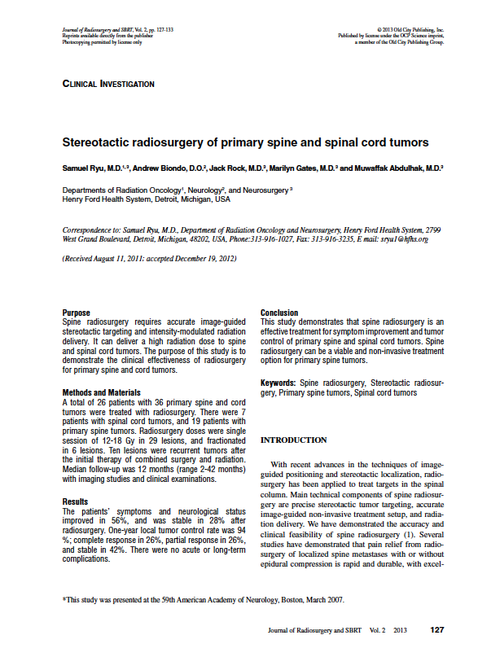- Home
- Journal Contents Downloads
- JRSBRT Downloads
- JRSBRT 2.2, p. 127-133
Product Description
Stereotactic radiosurgery of primary spine and spinal cord tumors
Samuel Ryu, Andrew Biondo, Jack Rock, Marilyn Gates and Muwaffak Abdulhak
Purpose: Spine radiosurgery requires accurate image-guided stereotactic targeting and intensity-modulated radiation delivery. It can deliver a high radiation dose to spine and spinal cord tumors. The purpose of this study is to demonstrate the clinical effectiveness of radiosurgery for primary spine and cord tumors.
Methods and Materials: A total of 26 patients with 36 primary spine and cord tumors were treated with radiosurgery. There were 7 patients with spinal cord tumors, and 19 patients with primary spine tumors. Radiosurgery doses were single session of 12-18 Gy in 29 lesions, and fractionated in 6 lesions. Ten lesions were recurrent tumors after the initial therapy of combined surgery and radiation. Median follow-up was 12 months (range 2-42 months) with imaging studies and clinical examinations.
Results: The patients’ symptoms and neurological status improved in 56%, and was stable in 28% after radiosurgery. One-year local tumor control rate was 94 %; complete response in 26%, partial response in 26%, and stable in 42%. There were no acute or long-term complications.
Conclusion: This study demonstrates that spine radiosurgery is an effective treatment for symptom improvement and tumor control of primary spine and spinal cord tumors. Spine radiosurgery can be a viable and non-invasive treatment option for primary spine tumors.
Keywords: Spine radiosurgery, Stereotactic radiosurgery, Primary spine tumors, Spinal cord tumors
After payment has been processed for your order of a digital copy (PDF) of this article, you will see a download link on your completed order page and also receive an email containing a download link. The links, which will enable you to download one copy of the article, will expire after 24 hours.
 Loading... Please wait...
Loading... Please wait...



